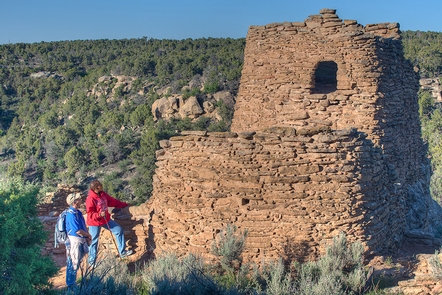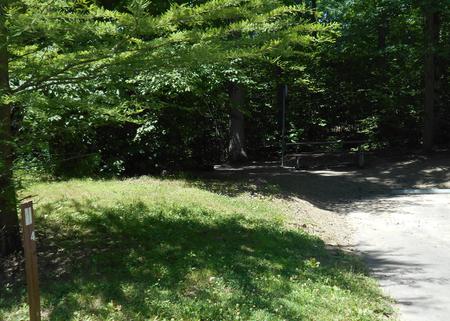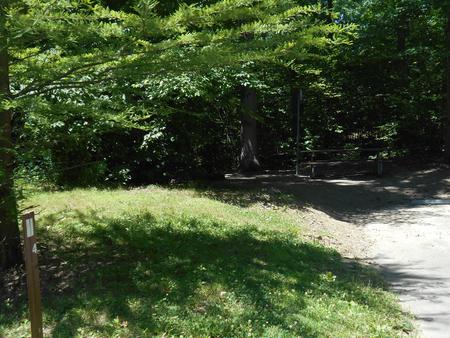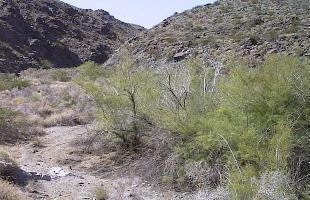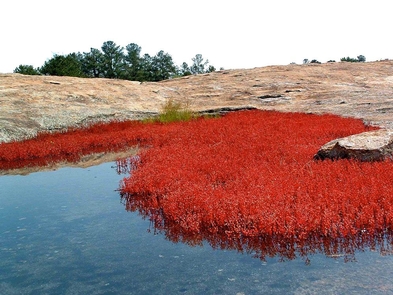Directions
Simon Canyon Ruin
Simon Canyon Ruin can be reached by driving to the parking lot and picnic area for Simon Canyon Recreation Area, located on the north side of the San Juan River, 3.5 miles below Navajo Dam. A moderate half-mile hike leads to the site.
Frances Canyon Ruin
To access the site, take NM Hwy 527 north from US 64 to mile marker 11, and turn left (west). Follow the road to the mesa top. Continue to follow the road to a “T” intersection approximately 2.5 miles from the base of the mesa. Turn right (south) and continue an additional 0.5 miles, then keep left at the Y-intersection, continue about 400 feet, then turn left (northeast), and follow the pipeline about 0.2 miles to the parking area. A short, gentle hike leads to the site.
Crow Canyon
To reach the petroglyphs, a high-clearance, four-wheel drive vehicle is recommended. Take County Road 4450 for 19 miles south from its junction with Highway 64. Follow the signs across Largo Wash, and then turn north and drive approximately one mile to the mouth of Crow Canyon. (NOTE: Do not cross either wash when water is present, and caution should be used when sand is either very wet or very dry. Get out of your vehicle to check the condition of the wash). Signs direct you to the main panels at the mouth of the canyon. To see the “44 Panel,” follow the road up the canyon, and then park at the well pad. Signs direct you to the trail to the “44 Panel,” a hike of about 3/4 of a mile.
Tapacito Ruin
From the bridge at Largo School Ruin, continue south on the Largo Canyon Road for approximately 2.5 miles, to where Tapacito Creek enters Largo Canyon. Cross the wash (there is no bridge – only cross the washes if there is no water present). Follow the road up Tapacito Canyon for approximately two more miles, and then take the road across the creek. Double back on the road on the other side of the creek toward Largo Canyon for approximately 2.4 miles and park at the small parking area. The pueblito is only a short walk from the parking area.
Split Rock Ruin
To access Split Rock Ruin, continue along the road past the parking area at Tapacito Ruin for an additional half mile. A two-track trail can be seen leading east from the main road at this point. Park alongside the main road and follow the easy trail to the interpretive sign at the base of the cliff.
Hooded Fireplace Ruin
To reach Hooded Fireplace, travel south along the Largo Canyon Road (County Road 4450) for 1.8 miles south of the bridge at Largo Canyon School. Turn west up a steep road that climbs out of the canyon to the first bench. Keep to the right and continue north for another two miles. Hooded Fireplace is clearly visible above the road to the west.
Largo School Ruin
To reach Largo School Ruin, continue north past Hooded Fireplace approximately a quarter of a mile, to a small parking area on the east side of the road. From the parking lot it is an easy half-mile hike to the pueblito, mostly following an abandoned two-track road.
Phone
505-564-7600
Activities
HISTORIC & CULTURAL SITE, HIKING
Camping Reservations
Reserve your campsite at these camping areas:
Hiking Trails
Looking for nice hiking areas to take a hike? Choose from these scenic hiking trails:
Related Link(s)
More New Mexico Recreation Areas
BLM New Mexico YouTube Channel
BLM New Mexico YouTube Channel
The small, aboveground masonry structures of northwestern New Mexico called “pueblitos” (Spanish for “little pueblos”) drew the attention of the first European visitors to this area centuries ago. The pueblitos were observed by Spanish travelers in the early to mid-1700s, who remarked that they were places of defense against the Utes and Comanches. The early 20th century residents of the Gobernador area used the term pueblitos in reference to these small stone structures. In the early 1900s, the noted archaeologist Alfred Kidder proposed that these structures might have been built by Puebloan refugees fleeing Spanish reprisals after the Spanish resettlement of New Mexico in 1692, although research since then has well established that most, if not all, of the pueblitos were constructed by the Navajo (Diné).
These “Pueblitos of Dinétah” (pueblitos in the homeland of the Diné) were constructed in the 17th and 18th centuries and used defensively as well as for shelters and cooking. They are often situated on large boulders or outcrops, allowing the residents to have maximum vantage points. Architectural elements include roofs, hooded fireplaces, hogan foundations as well as peep holes for doorway security.
Pueblitos under the jurisdiction of the Bureau of Land Management include Simon Canyon Ruin, Tapacito Ruin, Split Rock Ruin, Frances Canyon Ruin, Hooded Fireplace Ruin, Largo School Ruin, and Crow Canyon Site. All of these sites were listed on the National Register of Historic Places in 1974 and 1987.

